The piece of the month of May 2018
A BOOK OF EMBLEMS ON SAINT FRANCISCO JAVIER: DAPHNIS PASTOR
Eduardo Morales Solchaga
Chair of Navarrese Heritage and Art
During the centuries of the Baroque, and more specifically in the Jesuit sphere, the emblematic compositions in which graphic and literary art went hand in hand, gained great importance, popularizing all subject of repertoires of companies, currencies and hieroglyphs. Many times they were authentic hagiographies, in which the most outstanding facts of the lives of the saints were accompanied by interesting illustrations, which with wit and sharpness complemented them perfectly. In the case of St. Francis Xavier, the most universal Navarrese, only one manuscript preserved in the Library Services Royal Brussels has been studied so far, in which he shares the limelight with St. Ignatius. With this modest study we intend to make known an unusual and monographic repertoire on the missionary saint, preserved in a private collection in Pamplona.
It is an octavo copy (11 x cm.), which saw the light in Vienna (1719) under the university press of Maria Eva Schmid, widow of Simon Schmid. It bears the degree scroll Daphnis Pastor. It is a combination of prose and verse dedicated to St. Francis Xavier as patron saint of philosophers, illustrated with circular emblems. The modest edition was printed to commemorate the graduation of a graduating class of Philosophy at the University of Vienna, presided over by Father Leopold Galler (1682-1761), philosopher, theologian and canonist, as indicated on the title page. The edition was position, according to the Society's own sources, by Marc Sautter (1680-1740), also a Jesuit and professor of Humanities and Rhetoric at the same university.
The format chosen by Sautter, an expert in Latin literature, was that of the eclogue or bucolic, a subgenre of lyric poetry consisting of a monologue or dialogue, often of topic love, between shepherds, which takes place in a natural and idyllic setting, in which music is also of great importance. As far as language is concerned, modern Latin is used instead of German.
The first known were the Idylls (small songs) of Theocritus, very influential in later Greek literature. But it was Virgil (1st century B.C.) with his Eclogues (selections) or Bucolics, who recovered and renewed the genre, hiding real characters, such as Julius Caesar or Octavian Augustus, under the figure of shepherds. This innovation passed to later bucolic poetry, recovering the genre in the Renaissance (Boccaccio/Sannazaro), either literally or incorporated into a prose narrative speech , spreading rapidly throughout Europe (Milton, Spencer, Garcilaso, Lope, Bernardin de Sant-Pierre...).
It is precisely Virgil's innovation that is the germ of the work that concerns us, since a parallelism is established between St. Francis Xavier, the most universal Navarrese, and the shepherd Daphnis, legendary creator of the bucolic genre, who appears for the first time in the homonymous poem by Theocritus, and who was later recovered by Virgil in his Eclogues. Obviously their life trajectories, so far apart in time and space, have little to do with each other, but rather with their virtues, gifts and skills, which are constantly compared in each of the pastoral compositions of the Viennese print.
As for the structure of the book, apart from the title page and the introduction, it is divided, like Virgil's Bucolics, into ten eclogues, which repeat the same structure. First there is a lauda to St. Francis Xavier in prose, all of them written by Jorge Naperth, and whose last sentence serves as a nickname for each of the intaglio emblems (without author's mark) that accompany it. After the corresponding motto, the Virgilian eclogue itself is presented, composed by one, two, three or even four students of the class. The work ends with a list of the students who participated in its essay, distinguishing between counts, barons, very illustrious, nobles and notables, who offer it with a Jesuitical "A mayor Gloria de Dios" (To the greater glory of God).
The illustration preceding the title page gives a good idea of the subsequent content. An allegory of bucolic poetry appears, following the model established by Cesare Ripa, in the form of a Roman matron, crowned with laurels, holding a trumpet and a pitchfork, while at her feet are a lute and a syringa. She is accompanied by an entourage of two small shepherds, one playing the flute and the other carrying wheat. All of them observe a bust, of classical evocation, of St. Francis Xavier, dressed as a pilgrim and clutching a crucifix. The following phrase can be read at the base: "Semper honos nomenque tuum laudesque manebunt" (your honor your name and your praises will last forever), taken from Virgil's fifth eclogue, more specifically from the apotheosis of the shepherd Daphnis narrated by Menalcas. In this way, both the binomial Saint Francis Xavier-Daphnis and the Virgilian structure of the work, coming from the bucolic or pastoral poems, are intertwined.

In the introduction, the compendium is dedicated to the Navarre saint and justifies the choice of the format described above, which combines prose, poetry and emblems. They also explain the choice of the moon as a symbol of Xavier, son and follower of the sun Saint Ignatius - two of the preferred symbols since the celebration of the first century of the Society -; and the comparison with the shepherd Daphnis, for the use of the pastoral genre. It concludes with a sentence similar to the one engraved on the bust on the cover, which gives way to the compositions.
The first of the texts stresses the indispensable role of St. Ignatius in the conversion of St. Francis Xavier in Paris. It is illustrated with an emblem that, apparently, has not been extracted from any particular repertoire, although its nickname is frequent in hagiographies and lives of notable persons, making reference letter both to God and to lineages and lineages: "sequitur vestigia patris" (follow the trail of the father). In the circular emblem and on an idyllic landscape two stars are contemplated: on one side the sun, representing St. Ignatius; on the other the moon, symbolizing St. Francis Xavier. Above them are shown the zodiacal signs, so present in many emblems referring to the celestial bodies. The eclogue that accompanies it makes a comparison between this conversion and the one Juginta makes with Daphnis, whom he convinces to follow the way of virtue. It was composed by Antonio José, Baron of Graan, Pedro, Count of Coronini, and Ignacio Hoffmann.

The second one emphasizes the figure of St. Francis Xavier as shepherd and healer of souls, concluding with a "niveum dat visa decorem" (spread the whiteness of snow) that serves as a nickname for the circular emblem in which a moon can be seen illuminating the landscape as if it were the sun king. In this case, we find a reference letter to the emblem in Piccinelli's celestial corpus as a Marian emblem, later taken as loan: "the mere presence of the most holy virgin inspired chaste and pure ideas in men". The eclogue that accompanies it establishes a binomial between the healing work of both Daphnis (with the sheep) and St. Francis Xavier (with the pagan souls). Menalcas, Coridón, Mopso, Títiro, Meris, Melibeo and Dafnis take part in the composition. The authors were Juan Ernesto Carlo de Crolallanza (1701-1780), knight of the Holy Empire, and Francisco José Sachers.
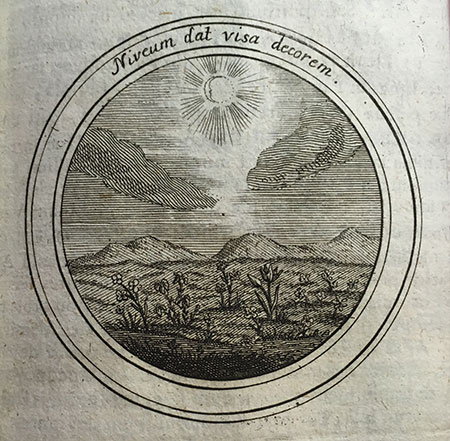
The third composition begins with a text that makes reference letter to the Saint Francis Xavier traveler, who from his cradle in Navarre, and after his passage through France and Italy, leaves for the Indies to convert the gentiles. The composition concludes with the motto of the motto that is printed below "pretium distando facit" (for the distance is worth more). The structure of the emblem is again simple, featuring a moon illuminating the earth. Piccinelli again throws an explanation for it: "If it is true that the brightness of the moon is greater the farther it moves away from the sun, you will rightly draw the moon far away from the sun with this motif taken from Martial. With this emblem, Father Girolamo Gambarti showed that, thrown from the fortress of Turin the king of France and his garrison, the excellence of the Duke of Savoy in the manner of a silvery moon by his serene majesty, shone brighter than at any other time." Taking it from reference letter, it can be established that the missionary saint shone more brightly the farther he was from St. Ignatius and his native land. The eclogue that accompanies this third emblem establishes a binomial between the travels of St. Francis Xavier and those of the shepherd Daphnis following in the footsteps of Lycidas (France), Thirsis (Italy) and Palemon (Spain). The authors of the text were José Antonio Pranz, José Fernando Perl and Ignacio José de Richtern, knight of the Holy Empire.
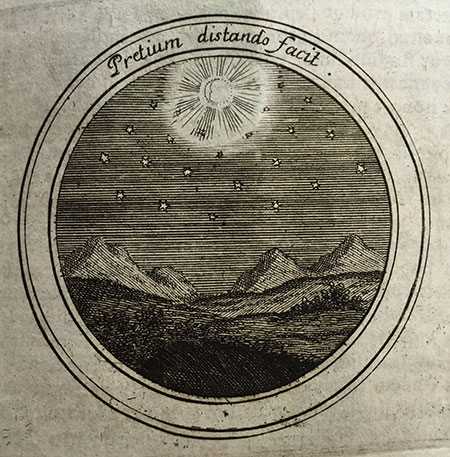
The fourth text begins with a reference letter to the gift of tongues that was attributed to St. Francis Xavier, qualifying it as the most effective of weapons. The loa concludes with the phrase "terris dissita lustrat" (illuminates in dispersed lands), which serves as a nickname for the motto that accompanies it, in which three moons cover the entire horizon. In principle it does not come from any specialized repertoire, but there is a parallelism with a medal of Philip V, with a similar nickname, that makes reference letter to the visit that makes by its diverse territories in Europe (1702). The eclogue that accompanies it compares the scope of St. Francis Xavier's gift of tongues with the projection of the song and music of Daphnis. Belis, Philemon and Damoetas take part in the composition. Its essay ran to position of Francisco José Schinnagl and Cristóbal Jerónimo de Braitenbuch.
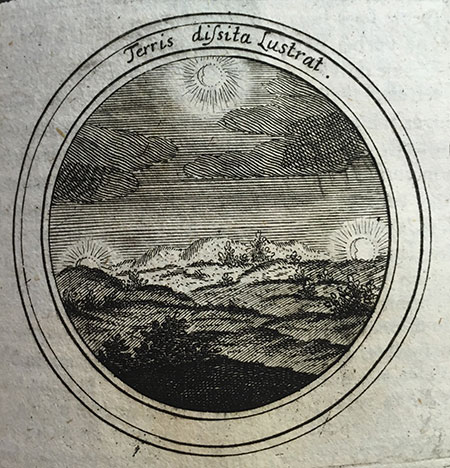
The following one emphasizes the founding character of St. Ignatius and St. Francis Xavier. The sentence "tam sola solem aequat" (when alone, it is equal to the sun) closes the speech . The emblem is taken from the "Divisas heroicas y morales" of the Jesuit Father Pierre Lemoine, published in 1649. It represents, under zodiacal signs, the sun in the West (Ignatius), and, on the other side of the ocean, the moon in the East (Xavier). In the original compendium, the emblem (simply a full moon rising in the sky) is accompanied by a brief metrical composition in which the moon is equated with the regent, who acts as king until there is a successor, just as she acts as sun during the night and until a new day arrives. The accompanying eclogue relates St. Ignatius and St. Francis Xavier, who under the figures of Juginta and Daphnis narrate the fruits obtained in Europe and Asia, respectively. The authors of the text were Juan Jorge Reizenstein, Francisco Adán Stierpöth, prince of Hohenzollern, and Count José Leopoldo de Cozzoli.
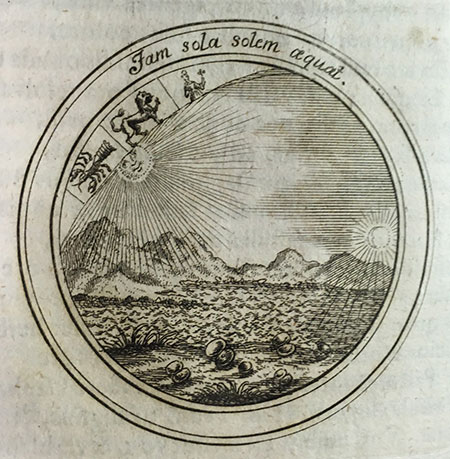
The sixth composition makes reference letter to the control of the elements by the Navarrese saint, as well as to his prodigies and conversions. The text closes with "hoc motore fluo, refluo" (with this movement I flow, I reflux). The emblem that accompanies it represents the full moon illuminating an ocean agitated between two lands, being appreciated in the horizon a small ship, making reference letter to the means of transport more used by San Francisco Javier. In principle, the motto does not come from a specific repertoire and could well have been devised for the publication studied here. The eclogue that accompanies it compares the skill of Daphnis in the art of fishing with the work of St. Francis Xavier as a fisherman of souls in the East. Besides the shepherd, Egón, Títiro and Amintas intervene. The authorship of the passage ran to position of José Francisco Knol and Juan Schwärzl, who does not appear in the list of notables at the end of the work.
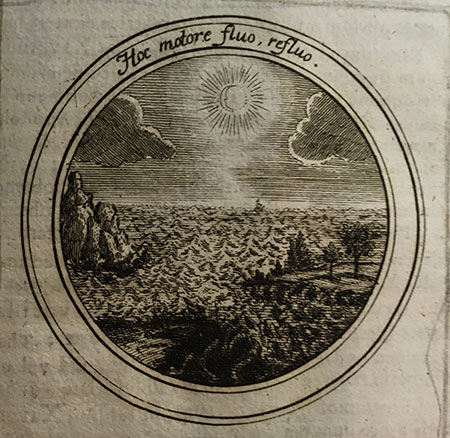
The text that follows emphasizes the role of St. Francis Xavier as a penitent saint, making reference letter to the passage of the blasphemous soldier, and comparing the saint to the pelican that self-harms to feed its young. It concludes with a "hoc afflata corusco" (it is by his radiance that I shine), which serves as a nickname for the emblem that illustrates it, representing the sun and the moon illuminating two small towns, and symbolizing Xavier as a mirror of Ignatius. The composition is taken from the Philosphia Imaginum (1695), one of the seven repertories of Father Menestrier (1631-1705), then a Jesuit, and the most important theorist of emblematic culture in the 17th century. The eclogue that accompanies the composition establishes a parallelism between St. Francis Xavier, who cares for his particular black sheep (the Portuguese soldier), and the shepherd Daphnis, who neglects the flock to find a lost sheep. The composition was done at position by Joseph, Baron of Zwenkau, Leopold, Lord of Schikh, knight of the Holy Empire, and Franz Rudolf Würth.
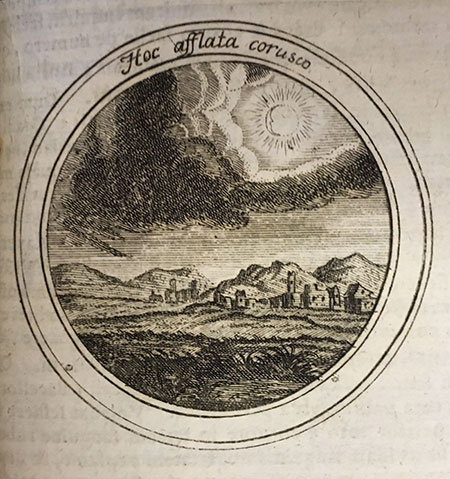
The eighth passage delves into the prodigious miracle of St. Francis Xavier, who drove the tigers away from the island of Sancian by sprinkling them with holy water. The composition concludes with the motto "eliminat, et illuminat" (eliminate and illuminate), which serves as the nickname for the corresponding emblem, in which a full moon illuminates the landscape and scares away two pairs of bats. The motto also comes from Father Menestrier's repertoire, but in this case it is applied to the aurora (she chases the night, she gives us the day). For the Jesuit, this emblem applies to saints who expel demons, in our case, tigers. The hieroglyph is found in other repertoires such as Symbolographia ( 1702) by Jacobo Boschio, also a Jesuit, who links it directly to the figure of St. Francis Xavier (he drives out demons and restores clarity). In the eclogue that accompanies it, the shepherds Títiro and Melibeo gloss the feat of Samson and the Lion, equating it with that of the Navarrese saint. This composition was written at position by Carlos, Count of Hardegg, Antonio Leopoldo Perl and Francisco Haveisen.
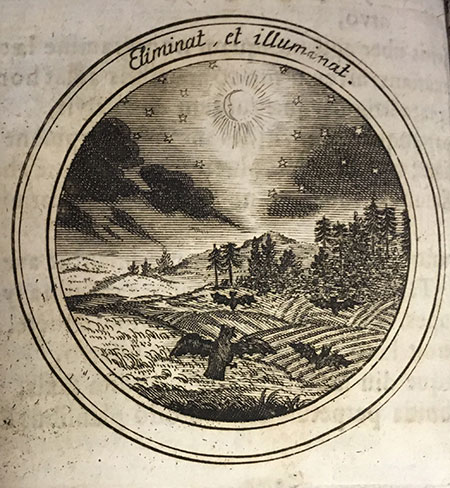
The following one focuses on Xavier's missionary work in the East, both quantitatively and in the particular way in which he did it. The loa concludes with a "lateo, non minuor" (I hide myself, but I do not diminish), which serves as a nickname for the accompanying intaglio motto, taken from Picinelli's repertoire. The emblem shows the transition between day and night; the sun and the moon, which only sample half of its face. For the Italian author, this emblem refers to characters famous for their birth and wealth, who although they leave their homeland for foreign regions, do not suffer any diminution in their name. He exemplifies it with the example of Scipio, and it fits perfectly with St. Francis Xavier, who continued to shine in the East. In the eclogue that accompanies him, the shepherds Damon, Lycidas and Coridon enumerate their loves, while Daphnis sample his desire to leave for China, again equating himself with the Navarrese saint. The authorship of the same corresponds to José Jorge Altschaffer, Francisco - Count of Liechtenberg - and Carlos Moreiz.
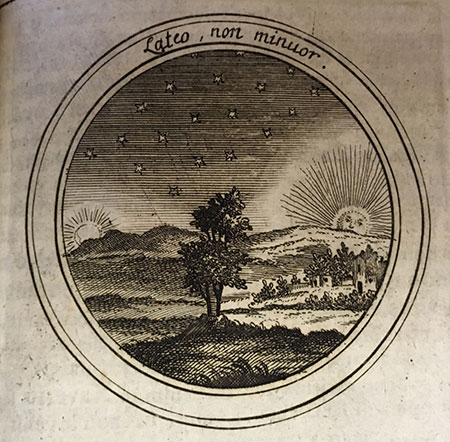
The work concludes with an extensive apotheosis of St. Francis Xavier, in which he makes reference letter to his immortal bequest and closes with "coelo datur, quod demittur orbis" (she gives to heaven what she offers to earth). The emblem that illustrates it sample how the moon, representing the saint, approaches the sun, over which the word 'God' in Hebrew is written. The motto is first recorded in the Speculum Symbolicum of Father Jacob Masen (1606-1681), a German Jesuit and Latin scholar, in 1650. It later passed to the repertories of Menestrier and Boschio, mentioned above. Picinelli also compiled a handful of similar emblems, and even the Imago Premi Saeculi, the first purely Jesuit compendium published years earlier, contains a variant of the pictura, although not the complete motto. The author affirms that the moon not only illuminates the earth, but also the sky, equating it with the great men whose good works in life are echoed in eternity. In the following eclogue, Lycidas, Tyrius, Thyrsis, Thirsis, Palemon, Mopso and Coridon, loan the figure and bequest of Daphnis after his death, in a lament that is both melancholic and hopeful. The authors were Juan Carlos de Maderna, Antonio Ehrlacher, Pablo Herdegen and Juan Tallman.
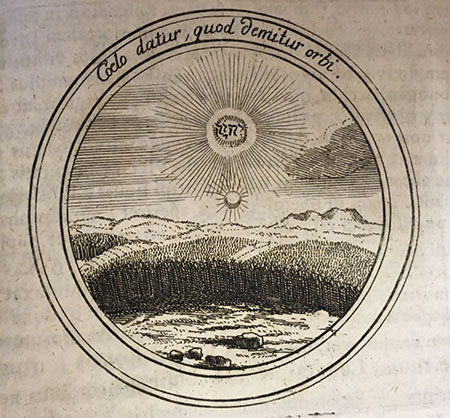
To conclude, it should be noted that the edition studied here is, to say the least, a rarity, since only a few copies are detected in Europe, preserved in the Library Services National Library of the Czech Republic, the Library Services National Library of Austria, the Library Services State Library of Bavaria, and the Library Services of Foreign Literature in Moscow, respectively.
BIBLIOGRAPHY
BOSCHIO, J., Symbolographia, Augsburg, Bencard, 1702.
GALLER, L. [ed.], Daphnis pastor: seu S. Xaverius philosophorum patronus per apostolicos vitae suae labores sacris eclogis celebratus et honoribus, illustrissimorum, perillustrium, reverendorum, religiosorum, praenobilium, nobilium, ac eruditorum dominorum dominorum AA. LL. & philosophi neo-magistrorum, Vienna, Schmid, 1719.
LEMOINE, P., Devises heroiques et morales, Paris, Courbe, 1649.
MASEN, J., Speculum imaginum veritatis occultae, Kinchius, 1650.
MENESTRIER, J. C., Philosophia imaginum, Amsterdam, Jansson-Waesberg, 1695.
PICINELLI, F., El mundo simbólico: los cuerpos celestes, libro 1, Michoacán, high school de Michoacán, 1997.
RIPA, C., Iconology [2 vols.], Madrid, Akal, 2010.
TORRES, G., Redes iconográficas. San Francisco Javier en la cultura visual del Barroco, Madrid, Iberoamericana, 2009.
VIRGILIO, P., Bucólicas (Églogas), Madrid, Castalia, 2011.
